 |

| ||
|
2491 Nozzles: 1x 2½", Location: Whittier, CA © Ken Patton |
1993 Nozzles: 2x 2½", Location: Campbell, CA ©2003 Don Jarvis |
|
Keystone Iron & Steel Works Keystone Iron Works - Los Angeles, CA Keystone Iron Works was founded in 1885 as a general jobber foundry. It became one of a growing number of "smoke-stack" industries which would enable Los Angeles to challenge San Francisco's dominance in manufacturing on the Pacific coast. Economic growth in the southwest was diverse, dynamic, and at times turbulent. Keystone moved to seize opportunity in the early 20th century with a number of product lines. These included Visible Vend (glass reservoir) gasoline pumps, farm tractors suitable for local agriculture, and wet-barrel fire hydrants. The patent of March 29, 1910, gave Keystone what it touted as a "special" valve. Thus armed, the company became a competitor to M. Greenbergs Sons in southern California. Keystone developed a strong presence in L.A. as well as providing other cities in the region with "first generation" hydrants. Keystone Iron Works had its financial challenges in times of rapid change, resulting in a reorganization in 1914. In 1917 the same principles formed Keystone Iron and Steel Works to absorb the assets of "Iron Works". Encouraged by the business surge surrounding WW-1, the new company built a large new plant. It was completed just as the recession of 1920 took hold and added both competitive and financial pressures. Even with the return of prosperity, Keystone struggled. A plant shutdown in April was followed by receivership in September 1926. California and Delaware charters were forfeited in 1928 and 1929 respectively. Keystone's plant closed in a period of high demand in L.A. and the surrounding cities. The result was groups of hydrants of Keystone design built in part, or completely, by other companies. These items have Keystone letters or logo as well as lettering for Alhambra Foundry, United Casting Co., M. Greenberg's Sons, or Pacific Cast Iron Pipe and Foundry Co. Orders involving the latter two companies were in process when United Casting Co. acquired Keystone product lines. On those items UCCO lettering replaced the Keystone lettering/logos partway through the production run. Today Keystone hydrants, both in the old, slim 4" flange and standard 6" flange varieties are few and far between. The last examples of a huge compliment of 2x41/2 items, are found only in LAFD country. -- Text by Ken Patton.
If you have any further information about the Keystone Iron Works, including old catalogs, advertisements, etc., that can be scanned, or if have any photographs of their hydrants not illustrated here that you'd like to contribute, please Contact Us. |
|
|
Identifying Characteristics: Small wet barrel hydrant with bolted top flange.
|
 |

| ||
|
2491 Nozzles: 1x 2½", Location: Whittier, CA © Ken Patton |
1993 Nozzles: 2x 2½", Location: Campbell, CA ©2003 Don Jarvis |
 |
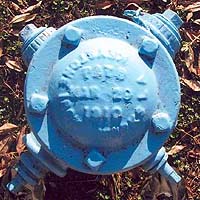 |
||
|
2490 Nozzles: 2x 2½", Location: Whittier, CA © Ken Patton |
2490b
© Ken Patton |
|
|
Identifying Characteristics: Wet barrel hydrant with bolted top flange. |

|
|||
|
1590 Nozzles: 1x 2½" ©2001 Ed Jarrell, Division Chief, El Cajon Fire Department |
|
|
Identifying Characteristics: 6" wet barrel hydrant with bolted top flange. |
 |
 |
||
|
2508 Nozzles: 1x 2½" © Ken Patton |
2513 Nozzles: 2x 2½" © Ken Patton |
|
|
|

|
|||
|
1843 Nozzles: 2x 4½" 1x 2 1/2" Wharf head (James Jones) Location: © Ken Patton |
|
|
|

|
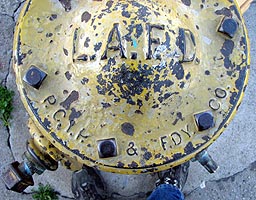
|
||
|
2512 Nozzles: 2x 4" Location: © Ken Patton |
2512b Bonnet View © Ken Patton |
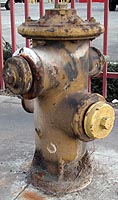
|
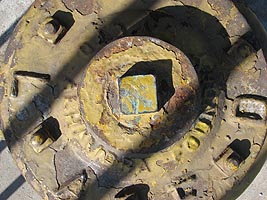
|
||
|
2507 Note: Bonnet is marked Alhambra Foundry, the Keystone logo is present on the barrel. ©Ken Patton |
2507b ©Ken Patton |
|
This is the drawing from the 1910 U.S. Patent assigned to the Keystone Iron Works of Los Angeles.
|
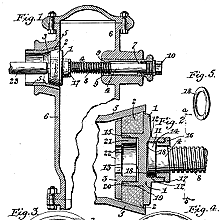 |
|||
|
|
|
|
| Unless otherwise noted, all contents of these WWW pages © FireHydrant.org |